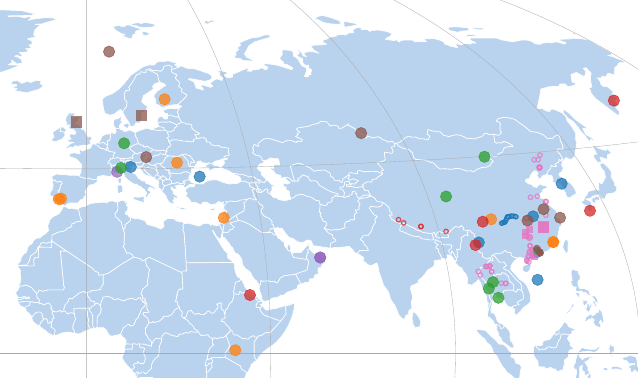Jeffrey M. Dick
This is my research page. See jedick.github.io for my tech portfolio.
What are the chemical drivers for the coevolution of the geosphere and biosphere?
This question drives my passion for building software for geochemical modeling and genomic data analysis.
This work uncovers new ways that life has adapted to past environments on Earth and is shaped by chemical conditions in modern habitats.

News
Recent CHNOSZ citations
Bioenergetic calculations for astrobiology: Glein (2024)
on exoplanet K2-18b and Sahai et al. (2024) on Europa.
Stability diagrams for uranyl-carbonate complexes: Migdisov et al. (2024).
First thermodynamic dataset and stability diagrams for carrollite: von der Heyden et al. (2024).
Speciation and stability of Pb-HS complexes: Wu et al. (2023).
2024-06-22
Data visualization
My data visualization portfolio is now available.
2024-03-21
chem16S paper published
Microbial communities obviously depend on their environment, but how do their genomes adapt?
To answer this question, we developed a method to represent community-level genomic differences using chemical variables.
Distinct chemical features for microbial communities in redox and salinity gradients is a major result.
Check out the chem16S paper in Bioinformatics
and the vignettes on this site!
2023-09-09

Recent CHNOSZ citations
Bioenergetic calculations for astrobiology: Glein (2024) on exoplanet K2-18b and Sahai et al. (2024) on Europa. Stability diagrams for uranyl-carbonate complexes: Migdisov et al. (2024). First thermodynamic dataset and stability diagrams for carrollite: von der Heyden et al. (2024). Speciation and stability of Pb-HS complexes: Wu et al. (2023). 2024-06-22
Data visualization
My data visualization portfolio is now available. 2024-03-21
chem16S paper published
Microbial communities obviously depend on their environment, but how do their genomes adapt?
To answer this question, we developed a method to represent community-level genomic differences using chemical variables.
Distinct chemical features for microbial communities in redox and salinity gradients is a major result.
Check out the chem16S paper in Bioinformatics
and the vignettes on this site!
2023-09-09

Research Areas

Thermodynamics
The CHNOSZ R package was first released 15 years ago.
It has a thermodynamic database to enable calculations for minerals and organic and inorganic species at high temperatures and pressures.
It allows reproducible generation of Pourbaix diagrams and other types of stability diagrams used in fields such as geochemistry and materials science.
CHNOSZ also makes stability diagrams for proteins to visualize environmental factors in genome evolution.
The thermodynamic database is periodically updated with new published data.

Genome adaptation to environments
Genome adaptation is usually discussed in terms of function, but it also has consequences for elemental composition of proteins.
We found global- and local-scale correlations between redox potential
(Eh values) and the carbon oxidation state of proteins inferred from microbal abundances and reference genomes.
This indicates that environmental redox conditions are encoded in genomes.
As a practical application of this phenomenon, we plan to use
genome-derived thermodynamic features in machine learning models to predict the environmental requirements of communities.
Human microbiome
Oxidation and hydration state are two chemical variables that differentiate communities in different body sites.
Compared to healthy controls, microbial communities associated with inflammatory bowel disease (IBD) and COVID-19 tend to have more reduced proteins even with decreasing abundances of obligate anaerobes,
revealing how these organisms are adapted to transiently oxidizing conditions in the gut.


Thermodynamics
The CHNOSZ R package was first released 15 years ago. It has a thermodynamic database to enable calculations for minerals and organic and inorganic species at high temperatures and pressures. It allows reproducible generation of Pourbaix diagrams and other types of stability diagrams used in fields such as geochemistry and materials science. CHNOSZ also makes stability diagrams for proteins to visualize environmental factors in genome evolution. The thermodynamic database is periodically updated with new published data.

Genome adaptation to environments
Genome adaptation is usually discussed in terms of function, but it also has consequences for elemental composition of proteins. We found global- and local-scale correlations between redox potential (Eh values) and the carbon oxidation state of proteins inferred from microbal abundances and reference genomes. This indicates that environmental redox conditions are encoded in genomes. As a practical application of this phenomenon, we plan to use genome-derived thermodynamic features in machine learning models to predict the environmental requirements of communities.
Human microbiome
Oxidation and hydration state are two chemical variables that differentiate communities in different body sites.
Compared to healthy controls, microbial communities associated with inflammatory bowel disease (IBD) and COVID-19 tend to have more reduced proteins even with decreasing abundances of obligate anaerobes,
revealing how these organisms are adapted to transiently oxidizing conditions in the gut.

Research Highlights
Stoichiometric hydration state (nH2O) is the amount of water in balanced chemical reactions that represent changes in protein expression levels. In an analysis of hundreds of proteomic datasets, cancer tissue generally exhibits higher proteomic nH2O than healthy tissue. These are the first results to suggest a physicochemical link between protein expression patterns and cellular water content, which is elevated in tumors and proliferating cells.
Connecting protein evolution to redox potential. A thermodynamic model was used to find chemical conditions that are most favorable for the formation of target proteins with different gene ages. Water activity and oxygen fugacity represent two dimensions of chemical variability (A), but the theoretical values are not directly comparable to measurements, so they were combined to calculate redox potential. This thermodynamic analysis of sequence data provides a record of redox potential in deep time (B) that is consistent with a possible origin of the first cells in a reducing environment on Earth.

